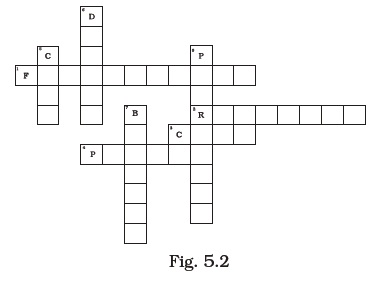Candidates can download NCERT Exemplar Class 8 Science Unit 5 from this page. The exemplar has been provided by the National Council of Educational Research & Training (NCERT) and the candidates can check it from below for free of cost. It contains objective, very short answer type, short answer type, and long answer type questions. Along with it, the answer for each question has also been provided. From the NCERT Exemplar Class 8 Science Unit 5, candidates can understand the level and type of questions that are asked in the exam.
NCERT Exemplar Class 8 Science Unit 5 Coal and Petroleum
NCERT Class 8 Science Unit 5 is for Coal and Petroleum. The type of questions that will be asked from NCERT Class 8 Science Unit 5 are displayed in the below provided NCERT Exemplar Class 8 Science Unit 5. With the help of it, candidates can prepare well for the examination.
Also Check: NCERT Solutions for Class 8 Science
Multiple Choice Questions
- Various materials which are obtained from nature are called natural resources. Which of the following is not a natural resource?
(a) minerals
(b) water
(c) soil
(d) plastic - Air is a natural resource and cannot be exhausted by human activities. It is known as inexhaustible natural resource. Which of the following is another inexhaustible natural resource?
(a) coal
(b) petroleum
(c) sun-light
(d) minerals - Which of the following is a pair of exhaustible natural resources.
(a) coal and soil
(b) air and sun-light
(c) water and petroleum
(d) wild life and minerals - Coal is processed in industries to get some useful products. Which of the following is not obtained from coal?
(a) coke
(b) coal tar
(c) coal gas
(d) CNG - Exhaustible natural resources are:
(a) unlimited in quantity.
(b) not dependent on nature.
(c) limited in quantity.
(d) not exhausted by human activities. - Fossil fuels are obtained from:
(a) remains of non-living materials.
(b) dead remains of birds only.
(c) dead remains of insects only.
(d) dead remains of living organisms. - Coal is formed from the remains of
(a) egetation only
(b) animals only
(c) both vegetation and animals
(d) neither vegetation nor animals - Which substance is formed by the carbonation of dead vegetation?.
(a) coal
(b) coke
(c) coal gas
(d) coal tar - Naphthalene balls are obtained from coal tar and are used as
(a) mosquito repellant
(b) honey bee repellant
(c) moth repellant
(d) snake repellant - Which of the following is not a constituent of petroleum?
(a) paraffin wax
(b) lubricating oil
(c) petrol
(d) coke - Petroleum was formed from organisms:
(a) living on the land
(b) living on the plants
(c) living in the sea
(d) living on the rocks - Choose the correct statement from the following:
(a) It is difficult to transport natural gas through pipes.
(b) The disadvantage of natural gas is that it can not be used directly for burning in homes.
(c) Natural gas is stored under high pressure as compressed natural gas.
(d) Natural gas cannot be used for power generation.
Very Short Answer Type Questions
- You are provided with a mixture of petroleum and water. Can you suggest a method to separate the two?
- What does CNG stand for and why is it considered to be a better fuel than petrol?
- Name the petroleum product used as fuel for stoves, lamps and jet aircrafts.
- Fill in the blanks in the following sentences.
(a) Coal is one of the ________ used to cook food.
(b) When heated in air, coal burns and produces mainly ________ gas.
(c) Coal tar is a black, thick ________ with an ________ smell.
(d) Petroleum, ________ and ________ are fossil fuels.
(e) Forests and coal are ________ natural resources. - The underlined words in the following sentences have been jumbled up. Write them in their correct form.
(a) Loca is obtained from mines.
(b) Umpetlore is a fossil fuel.
(c) Rineryfe is a place where various fractions of peroleum are separated.
(d) Keenrose is a fuel used in jet crafts.
(e) Nutsgilh is an example of inexhaustible natural resources. - Fill in the blanks.
(a) The slow process of conversion of dead vegetation into coal is called__________.
(b) Coal and petroleum are formed from the dead remains of organisms and are known as __________.
(c) The black thick liquid with __________ smell is known as coal tar.
(d) During the processing of coal to get coke, coal tar and __________ are also obtained.
(e) The process of separating the various constituents of petroleum is known as __________.
(f) Excessive burning of fossil fuels is a major cause of __________. - Write True/False against the following statements.
(a) Oxygen in air is an exhaustible natural resource.
(b) Resources which are present in unlimited quantity in nature are called exhaustible natural resources.
(c) Wildlife is an exhaustible natural resource.
(d) Under high temperature and pressure, dead plants get slowly converted to coal.
(e) CNG is less polluting fuel than petrol and diesel.
Short Answer Type Questions
- Sunlight and air are inexhaustible natural resources. Comment.
- Some natural resources are given in a box. Classify them into the exhaustible and inexhaustible natural resources.
air, coal, natural gas, sunlight, petroleum, minerals, forests, oxygen. - Write two important uses of coke.
- Write the characteristics and some important uses of coal.
- Look at Fig. 5.1 where petroleum and natural gas deposits are shown. Why do we find oil layer above water layer?

- Fill in the blanks and complete the story.
About 300 million years ago the earth had dense ________ in low lying wetland areas. Due to natural processes, like ______, these forests got burried under the ________. As more ________ deposited over them, they were compressed. The ________ also rose as they sank deeper and deeper. Under high ________ and high ________, dead plants got slowly converted into coal. - Match the items given in Column I with the items of Column II.

Long Answer Type Questions
- Name the products obtained and their uses when coal is processed in industry.
- We say fossil fuels will last only for a few hundred years. Comment.
- We read in newspapers that burning of fuels is a major cause of global warming. Explain why.
- While driving what are the tips we must follow to save petrol/diesel/natural gas?
- Imagine that all the exhaustible natural resources are exhausted by human activities. Do you think survival of living beings would be possible.? If yes, why?, If not, why not?
- Why petrol is exhaustible natural resource, whereas sunlight is not? Explain.
- Write some important uses of the various constituents of petroleum.
- Coal reserves are said to be enough to last for another hundred years. Do you think we need to worry in such case? Why or why not?
- What steps would you suggest for the judicious use of fossil fuels?
- Complete the crossword Fig. 5.2 with the help of the clues:

Across
1. Fuels obtained form dead remains of living organisms. (6,5)
2. A process by which the various constituents of petroleum are separated. (8)
3. A porous black substance obtained form coal. (4)
4. Another name for motor fuel. (6)
Down
5. The substance obtained by carbonisation. (4)
6. Fuel for heavy motor vehicles. (6)
7. A petroleum product used for road surfacing. (7)
8. Dead remains of sea animals got converted into it. (9)
Click here to download the NCERT Exemplar Class 8 Science Unit 5 Coal and Petroleum
Answers to Multiple Choice Questions
Mutiple Choice Questions

Very Short Answer Question

Short Answer Question


Long Answer Question



To get study material, exam alerts and news, join our Whatsapp Channel.

